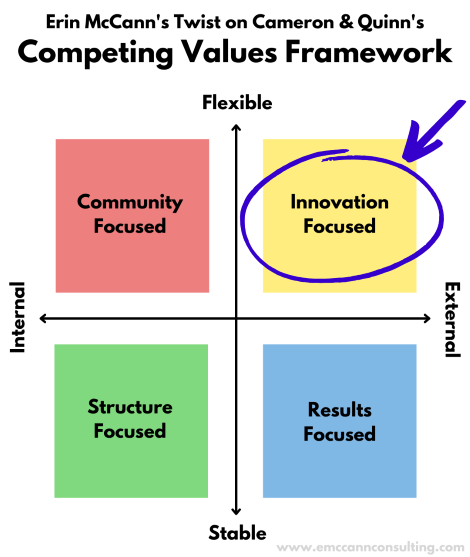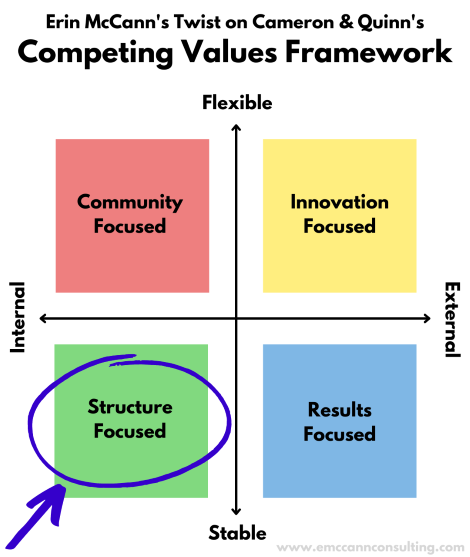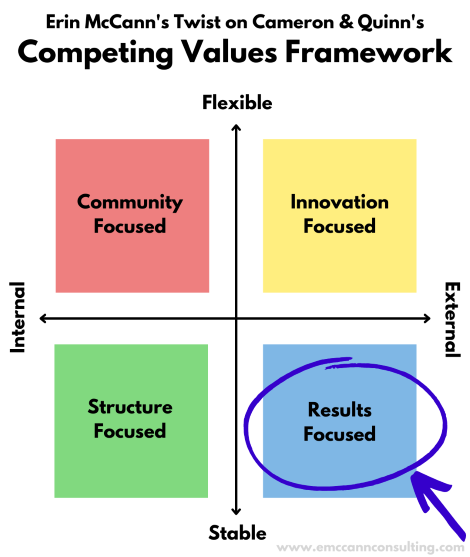4 Types of Organizational Culture
“Describe your organization’s culture” is a complicated question for which you are often expected to have a concise answer. As you consider how to answer this question (and all of the implied sub-questions that come with it), you may find it helpful to begin by zooming out and looking at the big picture. Luckily, experts have spent the better part of the last 40 years developing simple ways to broadly categorize organizational culture, and have made it as simple as identifying which of four categories your team (primarily) falls into.
More than likely, you will find that your organization doesn’t neatly fall into one box, and that’s ok. You may also find that this drums up more questions about how your organization can most effectively and intentionally be who you naturally are. This post (the first in a two-part series) is intended to help you understand the four types of organizational culture and see where among them your own organization is nestled. Worth noting: In the context of this framework, and the activities that follow, we are looking at your team culture, not the larger organizational culture (mentioned in previous blog posts) that includes other invested groups. As you read through this series, visualize the staff of your organization and how they operate as a team.
The Competing Values Framework
The most common way organizational cultures are classified is by using the Competing Values Framework, developed by Robert Quinn and Kim Cameron, which arose out of the research of Quinn and John Rohrbagh in 1983. This framework looks at cultures on two axes. Along the X axis, it considers whether an organization is centered more around an internal focus (on the team) or an external focus (on the product or customer). Along the Y axis, it considers whether the workstyle and strategic process tends to be more flexible (adaptive and change oriented) or stable (consistent and control focused). This results in four quadrants which Quinn and Cameron originally dubbed “Clan,” “Adhocracy,” “Hierarchy,” and “Market.”
There are a lot of variations to the names used to describe each quadrant of this model, but I have yet to see a set of names that are both clear and without negative connotations. With all due respect to the great thinkers that developed these concepts, I am updating the names of these quadrants to suit our time. There are no good and bad corners of this framework; there are only varied priorities, so I would prefer to use names that do each one justice. “Clan,” “Adhocracy,” “Hierarchy,” and “Market” are hereby renamed “Community-focused,” “Innovation-focused,” “Structure-focused,” and “Results-focused.”
Getting to Know the Four Types of Culture Styles
Before we delve in, I would like to clarify one thing: There is no right or wrong culture style. Each culture style serves a function, and they all fit the needs of different individuals and different organizations. It’s important to know your culture style so that you can communicate with current and future team members about who you are and set realistic expectations. This leads to talent retention! It’s also important to understand the strengths of each style and the pitfalls that they must avoid in order for you to be intentional about what you cultivate in your own organization. Remember the words of Dolly Parton, “Find out who you are and do it on purpose.”
Without further ado, let’s start getting to know the four types of culture styles:
Quadrant 1: Community-Focused Culture
The community-focused quadrant sits in the upper left-hand corner of the model because its approach is flexible and its focus is internal. This culture style is people-oriented and collaborative, and there is often an emphasis on enjoyment and creating opportunities for learning. Sometimes the goalposts change in order to prioritize the internal relationships (with respect to things like individual strengths and team capacity). These organizations believe that morale and cohesion will lead to success.
What’s in a name?
This quadrant was originally (and is most commonly) called “clan.” In my opinion, the word “clan” makes this style of culture feel closed off and inaccessible, where “community” is more welcoming and inclusive. This is a culture style that focuses on healthy relationships, so we should strive to conceptualize it as one that achieves greater effectiveness through striving to do right by one another.
This style works well for individuals who…
Are motivated by strong relationships and interpersonal connections.
Thrive when they are free to be vulnerable.
Value community care and a team approach to problem solving.
This style may be challenging for individuals who…
Prefer to keep their personal life private and completely separate from their work life.
Experience a greater sense of autonomy when their responsibilities are discrete.
Prefer performing an existing process with consistency and efficiency to seeking improvements to the process.
Quadrant 2: Innovation-Focused Culture
The innovation-focused quadrant sits in the upper right-hand corner of the model because its approach is flexible and its focus is on the product and/or the consumer. This culture style is dynamic and inventive, and it values ambition and creativity. These organizations often take a high-risk-high reward approach in the name of progress. They believe that innovation is the key to success.
What’s in a name?
This culture style is commonly referred to as “adhocracy” or “entrepreneurial.” I've chosen to rename this section “innovation-focused” because it’s more accessible than “adhocracy” and considerably easier to say than “entrepreneurial.” More importantly, innovation is truly what’s at the core of this culture and should be properly emphasized.
This style works well for individuals who…
Are always thinking about the next great idea or needed improvement.
Find their own satisfaction in the satisfaction of the customer.
Don’t mind leaving their comfort zone.
This style may be challenging for individuals who…
Prefer predictability in their work.
Are more interested in efficient and consistent productivity than constant improvement.
View unused or phased-out ideas as failures.
Quadrant 3: Structure-Focused Culture
The structure-focused quadrant sits in the lower left-hand corner of the model because its approach to the job is consistent and its focus is on the team. We may refer to this kind of culture as “process-oriented” because it emphasizes having the right person to fit each position and making sure that each position does their role consistently and effectively with respect to the others. These organizations don’t see the benefit of spending time fixing that which is not broken and are more concerned with maintaining quality and celebrating dependability. They believe that coordination and efficiency are the keys to success.
What’s in a name?
Let’s be honest, the original names for this quadrant (“hierarchy” and “bureaucracy”) weren’t doing it any favors. These words put a bad taste in some people’s mouths, and that does a great disservice to a cultural model that truly works for some people. I’m rebranding it “structure-focused” to emphasize how this culture benefits those who look for security and consistency in their work.
This style works well for individuals who…
Enjoy consistent work that highlights their own efficiency.
Thrive in an environment where directions are explicit and roles are clearly delineated.
Appreciate a formalized and dependable separation of their home life and their work life.
This style may be challenging for individuals who…
Look to their work for creative fulfillment.
Prefer more fluid group dynamics in the context of work.
Enjoy variety in the projects they are assigned.
Quadrant 4: Results-Focused Culture
The results-focused quadrant is situated in the lower right-hand corner of the model because it values consistency in planning and work, and its focus is external (prioritizing consumers). The emphasis of this culture style is on meeting and exceeding goals through efficiency and productivity. Overtaking the competition is what success looks like for these organizations.
What’s in a name?
While I don’t think “market” or “competitive” (two commonly used names for this culture style) are inaccurate, I recognize that (in a modern context) they may conjure imagery of an unhealthy relationship with gain and dominance for some people. This is simply the culture style that wants to see their persistence translate into commercial success, which is a valid perspective. Renaming this culture style “results-focused” highlights the value these organizations place on being the best they can be, rather than just being better than their competitors.
This style works well for individuals who…
Enjoy engaging their competitive side.
Believe that efficiency is the key to customer satisfaction.
Use market placement to define their success.
This style may be challenging for individuals who…
Prefer to focus on quality over quantity.
Derive satisfaction from the process rather than the outcome.
Prioritize relationships over productivity.
Where does your organization fall on this framework?
Even without taking an elaborate test, you’ve probably already noticed your organization’s unique culture reflected in this framework. What’s more, you probably saw yourself reflected to some extent in each one of the quadrants. That’s to be expected; our organizations are complex. It’s perfectly reasonable for you to want your team to feel valued AND want to rise to the top of your respective industry. These categories should be less of a prescriptive tool and more of a cheat sheet for conceptualizing your organization’s understanding of itself. For that reason, I think it’s important to both identify where you primarily see yourself as well as try to see your organization through the other three lenses.
For the moment…
Think about the work you do and the methods and messaging you share with incoming team members. Would you describe them as flexible (agile, nimble, experimental, adaptable), or would you describe them as stable (consistent, methodical, sound, tenacious)?
Think about how your organization currently prioritizes community, innovation, structure, and results, as well as how you see those priorities reflected in your day to day operations.
Draw a simple version of this framework on a piece of paper.
Draw an “X” in the quadrant that you think best represents your current culture. If you’d like to get fancy, you use the placement of your mark to show more detail: You may put it closer to one axis or another; you may put it closer to the center to show that you relate to other quadrants as well; you may place your mark close to the outer edge to indicate that you are firmly in one category, etc.
Draw a star in the framework where you want to see your organization’s culture in an ideal scenario.
Consider how your team and incoming team members see your culture. What first impression do you give to incoming team members? How do your teammates talk about their work and their work environment? Are these answers the same for the team members at the top of your org chart as they are for those at the bottom? Now draw an “T” in the quadrant where you believe your team sees your organization.
Finally, look at the placement of all three marks and ask yourself what they say about your organization. Are they in the same quadrant? Are they in dramatically different places? Why do you think that is?
Put some thought into these questions, and keep your drawing handy as you read part 2 of this series which will go more into detail about the strengths of each culture style and the pitfalls that each one must avoid. If the marks you made today are where you would like them to be on the framework, this next section may help you hone in on aspects of your quadrant and culture that you should further examine. If the current placement of your marks are less than ideal, part 2 may help you understand the cause and how to begin thinking through the solution.
Dolly Parton photo and autograph courtesy of Wikimedia Commons, the free media repository.








